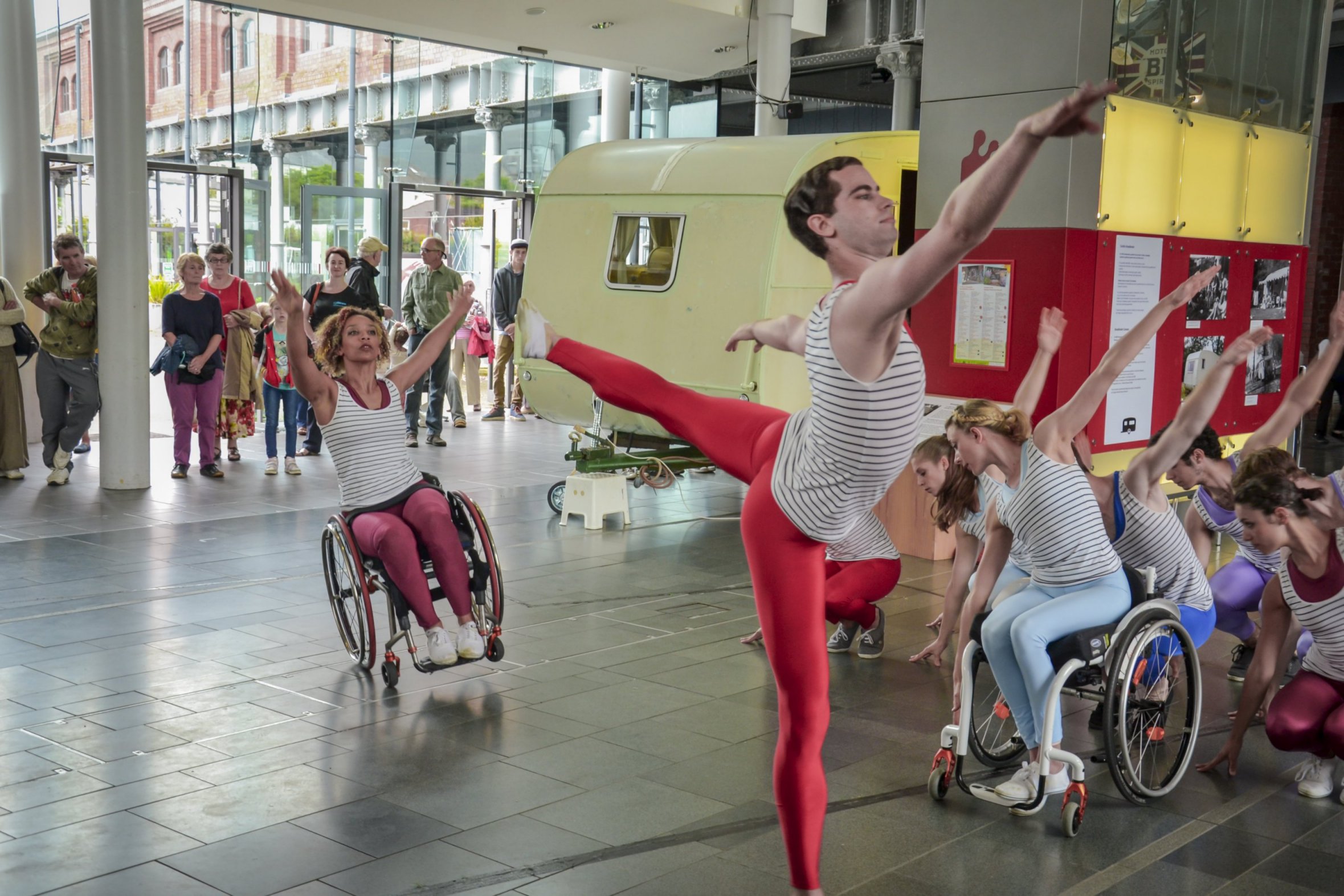
Alice Sheppard (Gdance) and Nicolas Capelle (Ballet Cymru) with professional cast at Swansea’s National Waterfront Museum
Photo: www.festivalchronicle.com
New artistic territory
Louisa Davison tells how two companies have pulled down the barriers between ballet and integrated contemporary dance.
For the last two years Stuck in the Mud has been touring; venues have included Gloucestershire’s Hidcote Manor Garden and Blackfriars, Newport’s market, Swansea’s National Waterfront Museum, Cardiff’s Wales Millennium Centre and Welsh seaside town Llandudno. The production has been a partnership between Gloucester-based producers GDance and Newport-based Ballet Cymru with big ambitions, namely to draw on classical ballet and contemporary dance genres, use professional disabled and non-disabled dancers and choreographers, incorporate a community cast, and promenade through outdoor venues – each performance is reworked to fit different casts and spaces.
“My biggest challenge wasn’t so much the choreography but the logistics of managing and working with so many people”
As with all successful collaborative projects, it began with shared values: the desire to produce high-quality integrated work which embraced the individuality of the performers – a dancer-centred approach. Both companies knew they could not do it on their own. Three years ago, GDance made a strategic decision: to concentrate on integrated dance in non-theatrical spaces and work solely in partnership. Ballet Cymru was interested in inclusive practice but to move forward it needed a partner with this experience. Marc Brew, Stuck in the Mud’s disabled Artistic Director and Lead Choreographer, has been the lynchpin of the partnership. “Marc’s ethos connected both of us. There was already trust as we both knew him and had worked with him. It felt like a very natural collaboration,” said Louise Brown, GDance’s Education Associate.
Working together meant they could explore new artistic territory and access Welsh partners and networks. Helen Crocker, GDance Producer, said: “We wanted the challenge of creating professional integrated ballet, normally a formalised dance genre with a prescribed aesthetic. This doesn’t yet exist in the UK. The scale of it – performed in outdoor non-theatre spaces, a large diverse cast – was what attracted the venues and festivals to become involved.” There were the usual logistical issues faced by a new relationship – different communication styles, paperwork and work schedules – which required extra time to work thorough. Marc said: “My biggest challenge wasn’t so much the choreography but the logistics of managing and working with so many people, ensuring there was an exchange of learning, sharing, people being challenged and enjoying the experience.”
Funds permitting, 2015 will see the beginning of a long-lasting relationship with Marc Brew as an Associate Director, and with Suzie Birchwood, a disabled dancer who performed in Stuck in the Mud and earlier this year with Ballet Cymru, and her company ActOne ArtsBase. Ballet Cymru wants to change the face of its classical dance genre, and has begun conversations with a leading UK vocational ballet school regarding the first-ever inclusive training in that field.
GDance is working on a legacy plan for Stuck in the Mud, conducting an in-depth investigation of inclusive ballet practice with dance organisations and networks. Talks have begun with the Royal Academy of Dance and a Gloucester dance academy. The show’s community partnerships in Gloucester and south Wales are also being revisited, and GDance is working on new relationships in London as part of a wider audience and participation development project. This will lay the groundwork for the next production, which explores the role of horses in the therapeutic recovery of wounded armed forces.
As with any successful working partnership, understanding, flexibility and a mutual appreciation are key qualities. But ultimately it is all about the performance.
Louisa Davison writes for Secret Agent Marketing on behalf of GDance.
www.gdancelive.co.uk
Join the Discussion
You must be logged in to post a comment.